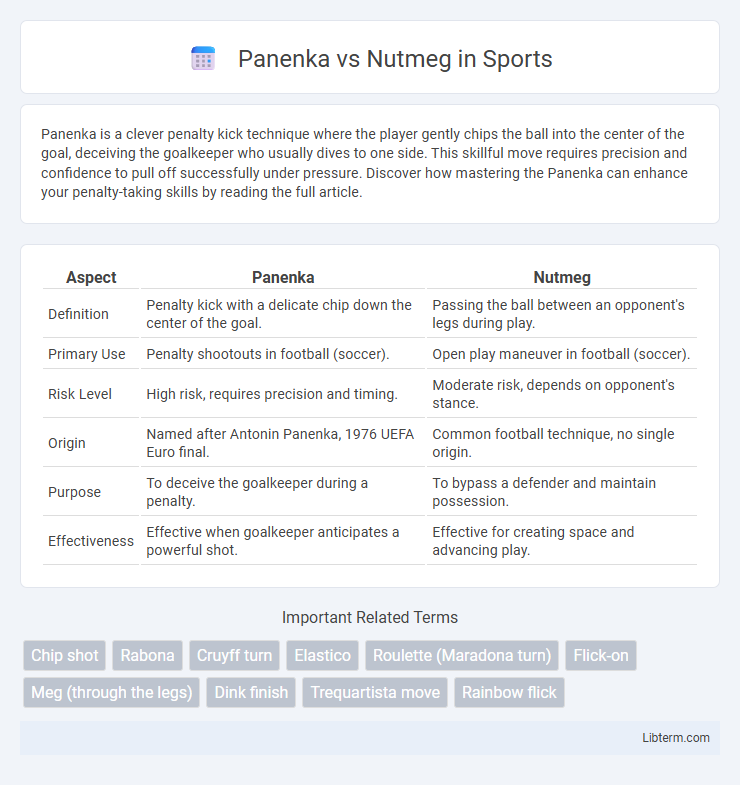Panenka is a clever penalty kick technique where the player gently chips the ball into the center of the goal, deceiving the goalkeeper who usually dives to one side. This skillful move requires precision and confidence to pull off successfully under pressure. Discover how mastering the Panenka can enhance your penalty-taking skills by reading the full article.
Table of Comparison
| Aspect | Panenka | Nutmeg |
|---|---|---|
| Definition | Penalty kick with a delicate chip down the center of the goal. | Passing the ball between an opponent's legs during play. |
| Primary Use | Penalty shootouts in football (soccer). | Open play maneuver in football (soccer). |
| Risk Level | High risk, requires precision and timing. | Moderate risk, depends on opponent's stance. |
| Origin | Named after Antonin Panenka, 1976 UEFA Euro final. | Common football technique, no single origin. |
| Purpose | To deceive the goalkeeper during a penalty. | To bypass a defender and maintain possession. |
| Effectiveness | Effective when goalkeeper anticipates a powerful shot. | Effective for creating space and advancing play. |
Understanding Panenka and Nutmeg: Definitions
Panenka is a football penalty technique characterized by a soft, chipped shot placed gently into the center of the goal, exploiting the goalkeeper's anticipation to dive to either side. Nutmeg, on the other hand, involves a player skillfully passing the ball through an opponent's legs to maintain possession or create scoring opportunities. Understanding Panenka and Nutmeg highlights the strategic use of deception and precision in football to outsmart defenders and goalkeepers.
Historical Origins of Panenka and Nutmeg
The Panenka penalty, named after Czech player Antonin Panenka, originated during the 1976 UEFA European Championship final when Panenka scored with a delicate chip down the center of the goal, exploiting the goalkeeper's dive. The Nutmeg, a skill move involving passing the ball between an opponent's legs, traces its roots to street football traditions, gaining prominence in global soccer culture for its flair and effectiveness in bypassing defenders. Both techniques have evolved into iconic displays of individual skill, symbolizing tactical ingenuity and psychological poise in high-pressure moments.
Technique Breakdown: Executing a Panenka
Executing a Panenka requires precise chip technique, where the player softly lifts the ball into the center of the goal, exploiting the goalkeeper's commitment to diving to either side. The key is using minimal power and a delicate touch, often striking the ball with the toe or the top of the foot, ensuring the ball arcs just over the goalkeeper's outstretched hands. Timing and deception are critical; the player must convincingly sell a powerful shot to manipulate the keeper's movement, making the subtle, softly chipped finish effective and difficult to save.
Mastering the Nutmeg: Skill and Precision
Mastering the nutmeg requires exceptional skill and precision to maneuver the ball cleanly between an opponent's legs while maintaining control and balance. This technique demands impeccable timing, spatial awareness, and a deft touch to exploit the defender's stance without losing possession. Successful execution of the nutmeg can create scoring opportunities and destabilize defensive formations, making it a valuable asset in a player's tactical repertoire.
Psychological Impact on Goalkeepers and Defenders
Panenka penalties exploit goalkeepers' anticipatory psychology by capitalizing on their tendency to commit early, leading to hesitation and increased vulnerability to the softly chipped ball. Nutmeg attempts trigger defenders' spatial awareness challenges, provoking anxiety from the risk of public embarrassment and breakdown of defensive structure. Both techniques manipulate psychological pressure, causing goalkeepers and defenders to second-guess decisions, often resulting in tactical errors and decreased confidence.
Famous Moments: Iconic Panenka and Nutmeg Goals
The Panenka penalty, first famously executed by Antonin Panenka in the 1976 European Championship final, remains an iconic symbol of audacity and finesse in football history. Nutmeg goals, where players elegantly pass the ball between defenders' legs, highlight moments of skill and humiliation, with legends like Ronaldinho and Lionel Messi enchanting fans worldwide. Both techniques have produced unforgettable highlights that continue to be celebrated for their creativity and impact on the game.
Risks and Rewards: When to Use Each Trick
The Panenka offers high rewards by catching the goalkeeper off-guard with a cheeky chip, but it carries the risk of an easy save or embarrassing miss if predicted. Nutmegging an opponent requires precise timing, rewarding players with unexpected control and crowd admiration but risks losing possession if poorly executed. Optimal use of the Panenka is in high-pressure penalty shootouts with confident execution, while the nutmeg excels in one-on-one dribbling scenarios where creativity and agility dominate.
Training Drills to Improve Your Panenka and Nutmeg
Mastering the Panenka and Nutmeg requires targeted training drills that enhance precision, timing, and deception. For Panenka practice, repetitive penalty shot simulations emphasizing soft touch and confidence under pressure improve execution, while cone drills refining approach angles strengthen control. Nutmeg drills focus on close ball control and spatial awareness by practicing quick footwork around stationary and moving defenders to create openings for the ball to pass between opponents' legs.
Common Mistakes and How to Avoid Them
When attempting the Panenka or Nutmeg in football, common mistakes include poor timing, inadequate power, and telegraphing the move to defenders or goalkeepers. Players often misjudge the goalkeeper's or defender's position, leading to easy saves or dispossession. To avoid these errors, practice precise execution, maintain composure under pressure, and analyze opponents' tendencies to increase the success rate of these skillful techniques.
Panenka vs Nutmeg: Which Suits Your Playing Style?
The Panenka and Nutmeg are distinct football techniques that suit different playing styles and situations. The Panenka, a delicate chip over the goalkeeper, favors players with calm precision and confidence under pressure, typically used in penalty shootouts. In contrast, the Nutmeg involves skillfully passing the ball between an opponent's legs to bypass defenders, ideal for players with agility, quick thinking, and flair in open play.
Panenka Infographic

 libterm.com
libterm.com